The ultimate goal of Chain Abstraction is simple: developers can deploy anywhere.
Author: BRIDGET HARRIS
Compiled by: Deep Tide TechFlow
Chain Abstraction has become a hot topic, and the reason is obvious - everyone in the cryptocurrency field should be excited about tools that make it easier for consumers to participate on the chain.
But much of the discussion has not focused on how we got to this point. I believe it started with the fact that developers are also consumers. And now, they are forced to make choices between different ecosystems, technology stacks, and communities. This creates a locking mechanism, which sometimes leads developers astray from focusing on the right issues due to unfair and unsustainable incentive mechanisms. Developers are also users, and they should not be forced to choose where to build.
A core challenge for developers is trying to integrate their applications with a variety of different technology stacks and underlying infrastructure, or building infrastructure that can work across various applications and address community loyalty issues across ecosystems. In addition, there seems to be countless different standards in the cryptocurrency space, which is not helpful for developers either.
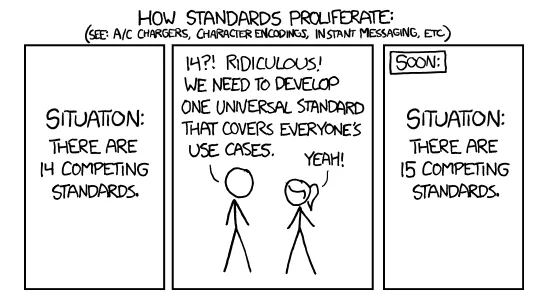
(Image source: xkcd: Standards)
Historically, this has often forced developers to only choose one ecosystem to build on, and the creators of ecosystems know this and actively vie for developers' attention, leading to further locking and unsustainability. The result is projects choosing half-hearted multi-chain extensions or delving deep into a single isolated ecosystem. Both have problems, and Chain Abstraction hopes to solve these problems.
The ultimate goal of Chain Abstraction is simple: developers can deploy anywhere, because there is no longer a need to reach users, and users can seamlessly interact across ecosystems, using any liquidity and any chain. Convenience is key, and the biggest beneficiaries may be those who submit order flows (increasingly centralized) interfaces.
Chain Abstraction as a concept is broad, loosely defined, and some even consider it to be completely false. Instead, it is just a collection of primitives, infrastructure, and tools that make operations for users and developers easier - many things fall within the scope of "Chain Abstraction". I agree with the latter view, while also believing that these advancements are generally positive and necessary steps.
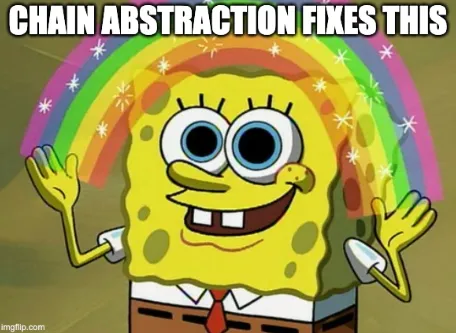
Below, I will provide a non-exhaustive overview of some companies building Chain Abstraction solutions and share my predictions for the future.
CEX as part of Chain Abstraction
The most commonly used Chain Abstraction platform may be Coinbase itself, although it is limited in the number of assets it offers and is centralized. Through one interface, users can buy and sell various tokens on different chains, albeit in a custodial manner. This is one of the main reasons why Coinbase has gained strong adoption and revenue in the entire Chain Abstraction field. It proves that convenience has a market, and users value and are willing to pay for the functionality and simplicity in one interface.
Core Layer Infrastructure
To truly take off Chain Abstraction, some believe that fundamental changes need to be made to the existing standards in the cryptocurrency space. One example is OneBalance, which is locally enhancing the existing JSON RPC (a cryptocurrency industry standard) to allow new standards to enable applications to communicate directly with wallets. Their new API is basically backward compatible with Ethereum, Bitcoin, Solana, and any assets and smart contracts on those chains. In addition to trading across three major chains, this architecture, called the CAKE framework, also includes gas abstraction, social recovery, and identity verification. Users benefit from fast state transitions, as solvers can request state transitions on the target chain without waiting for finality on the original chain. The ultimate goal is to integrate their account model into wallets, especially Metamask, so that users can directly benefit from this new architecture. Specifically, this means that users theoretically can use ETH to purchase WIF at Solana's speed (instead of Ethereum's speed).
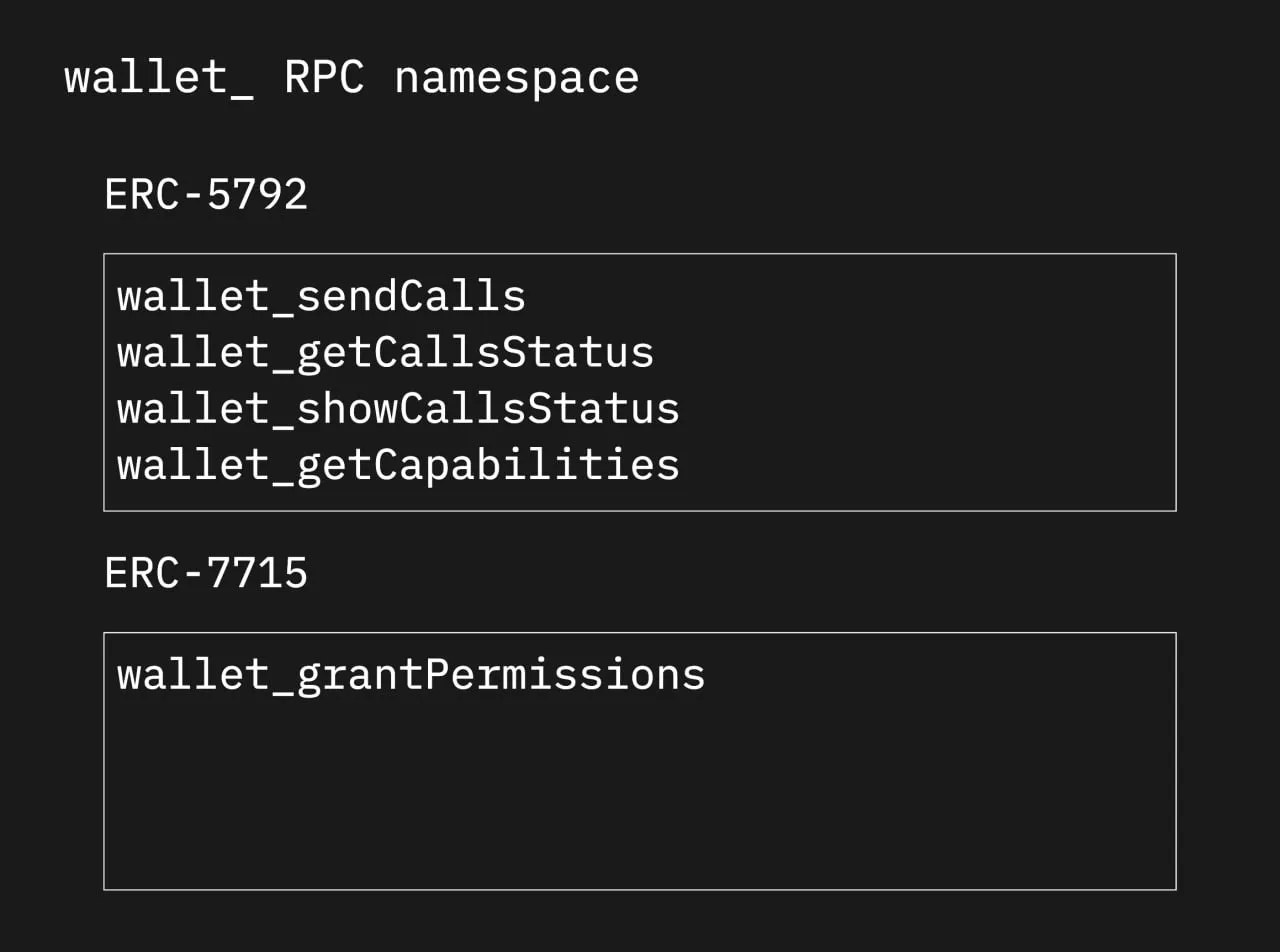
OneBalance's RPC method extension
Another company, Orb Labs, aims to be a provider of Chain Abstraction solutions at the node level rather than at the account level. Their system consists of OrbyEngine (an intelligent RPC endpoint that wallets can use to aggregate and orchestrate account states on all chains) and OrbyKit (a dapp SDK that provides the same functionality to the application front end). OrbyEngine uses a combination of a general intent protocol and a special node (called an account unification node) to aggregate and orchestrate account states.
In short, they allow any wallet or dapp to achieve Chain Abstraction, gas abstraction, etc. with just five lines of code. This fundamentally changes the way users interact with wallets, applications, and chains, so they no longer need to worry about bridging across ecosystems and manually moving assets. The chain just disappears, as users can trade with all accounts and assets from other chains no matter where they are. This fundamentally changes the idea of wallets as a medium connected to a specific chain, shifting to a chain-agnostic connection mechanism that focuses entirely on managing relationships between users, assets, and dapps.

NEAR is also on the core infrastructure side and has already integrated Chain Abstraction into their L1. Through their Chain Abstraction stack, developers can:
Choose to subsidize gas fees for users immediately, including conducting cross-chain transactions through NEAR's multi-chain gas relayer.
Utilize NEAR's multi-chain signature service, allowing users to transact on other chains using their NEAR accounts.
Use FastAuth, allowing users to register (or recover) NEAR accounts with their email address, providing a familiar Web2 experience.
These primitives are crucial for providing a more seamless experience for developers, and the experience created by these types of stacks positively extends to users.
Unified through bridging
At a higher level, many bridging providers are exploring Chain Abstraction, with the most notable being Across. The protocol has a fully functional (already released) intent engine, and relayers compete for the optimal execution path to fulfill user orders.
Today, Across is the only real-time cross-chain intent-driven bridging protocol that actually works for both large and small amounts. The market is responding: Across has processed nearly $10 billion in transaction volume and 6 million+ transactions. Developers can also easily integrate their bridging abstraction framework Across+ into dapps to natively enable Chain Abstraction. This is an early concept validation of what Chain Abstraction can do and how the market evaluates it.
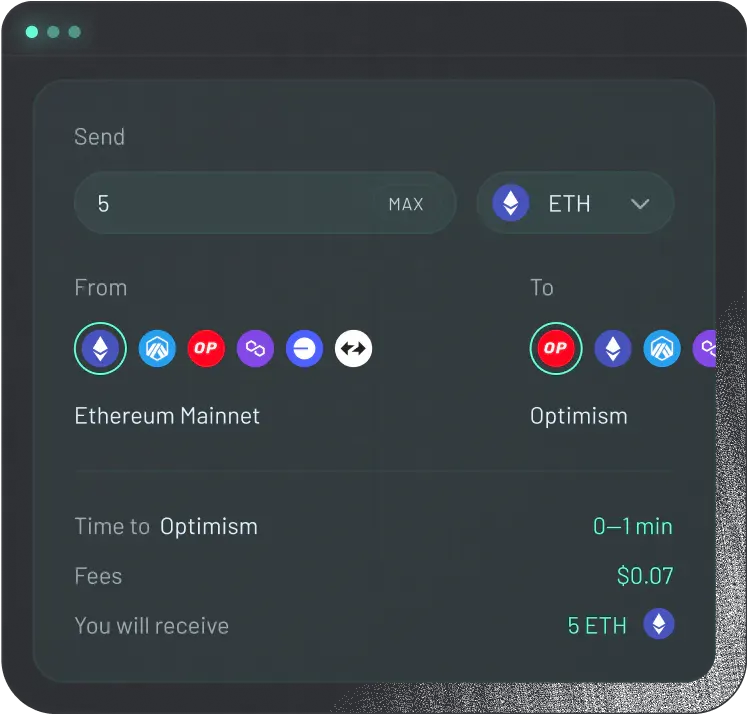
Socket, the maker of Bungee (a bridging aggregator), is also researching Chain Abstraction solutions through modular order flow auctions, where users submit intents and solvers compete to fill them. Through SocketPlugin, developers can add a widget to directly integrate Bungee (Socket's bridging aggregator supporting cross-chain asset transfers) into their projects. Most of the time, Bungee actually goes through Across, which reached about 50% of the trading volume share by the end of June 2024. In Socket and other aggregators, Across is cited as the cheapest bridging solution, accounting for about 78% of the time.
Integration Interactions
In addition to bridging (and staking, minting, borrowing…), exchanges are the most popular operations users conduct on-chain, and therefore the largest TAM that projects can tap into. Platforms like UniswapX and Matcha focus on exchanges, aiming to abstract gas, aggregate liquidity sources for cheaper trades, and enable efficient cross-chain transactions. This often involves some form of solvers that compete to fulfill order flows in the most efficient way. Solvers represent traders paying gas, increasing efficiency by batch processing orders together to get better prices, and users benefit from not having to worry about gas tokens.
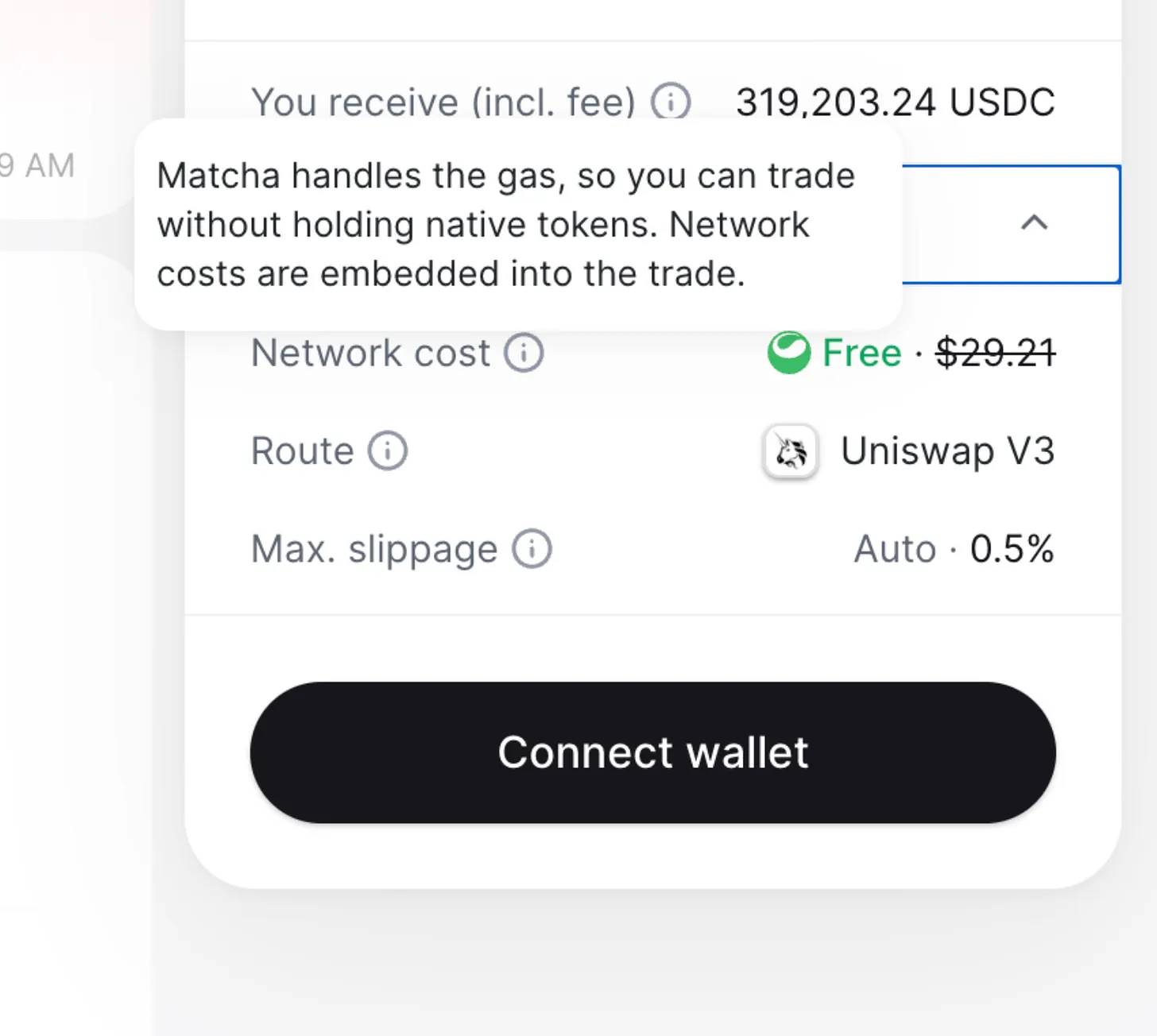
Middleware Frameworks and Interfaces
Some teams are building layers that support these protocols. For example, Light can sit as a middleware for other cross-chain interoperability protocols (including potential Across, UniswapX…), and serve as the middleware for Chain Abstraction in user interactions. It's worth noting that Light supports any configuration - conditions, DCA, intent graphs, etc. - expressed across multiple chains in EVM, while most intent-based protocols initially only support limit orders. Additionally, Light uses order flow auctions, where users can programmatically define conditions, security, and settlement of cross-chain transactions, helping to ensure optimal execution.
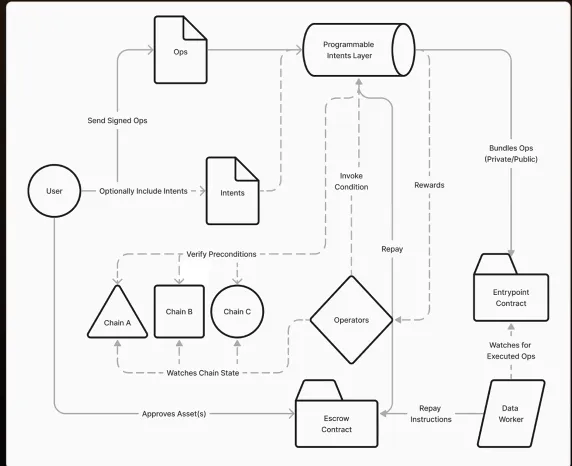
Another project in this space, Genius, is collaborating with Lit Protocol to build a Chain Abstraction solution, where Lit serves as the foundational signature scheme for Genius' liquidity architecture. Initially, they will support EVM, SVM, and Bitcoin, and focus on launching a decentralized relayer and aggregating liquidity, rather than going the intent route.
Intent as part of Chain Abstraction
Intents typically focus on exchanges, with the ultimate goal of allowing users to trade any asset across any chain without the need for bridging. The following projects have recently caught my attention:
Slingshot is an intent-based on-chain application where users can trade across different chains in a bridgeless, non-custodial manner. By creating an extremely simplified user experience - no gas tokens, no connect wallet buttons, no bridging, log in on any device, one-click buy/sell - users are more willing to participate on-chain. The downside here is that users are ultimately limited by the amount of funds held in the treasury of each supported chain, but regardless, this architecture encourages more on-chain activity.
Blackwing is using Initia to develop a decentralized trading abstraction layer. Their advantage is enabling margin trading without liquidation by using Uniswap LP positions as collateral. This effectively reduces the downside risk of major losses and also accelerates returns.
Essential is developing its own intent-based Optimistic L2, where solvers directly propose their solutions in the form of new states. In this case, fraud proofs are very concise, as only one constraint needs to be proven unsatisfied, which will be posted to L1. Developers can directly build applications with Essential's built-in intent framework using Essential's DSL (domain-specific language), allowing for more widespread and complex applications to exist and interoperate on their L2.
Enabling Mass Adoption through Abstraction
Just as you can access any website regardless of the browser or operating system you use, you should also be able to access any cryptocurrency ecosystem, regardless of which chain it is built on. And developers should not be at a disadvantage because they cannot access certain users in different ecosystems, no matter what technology stack they use to build. Achieving this is definitely easier said than done, but once achieved, I believe it will be a significant catalyst for mass cryptocurrency adoption.
Pedro Gomes wrote on Twitter: Chain Abstraction is the shift in software design from being "chain-centric" to being "user-centric". To make chains work for people, not teach people to work with chains.
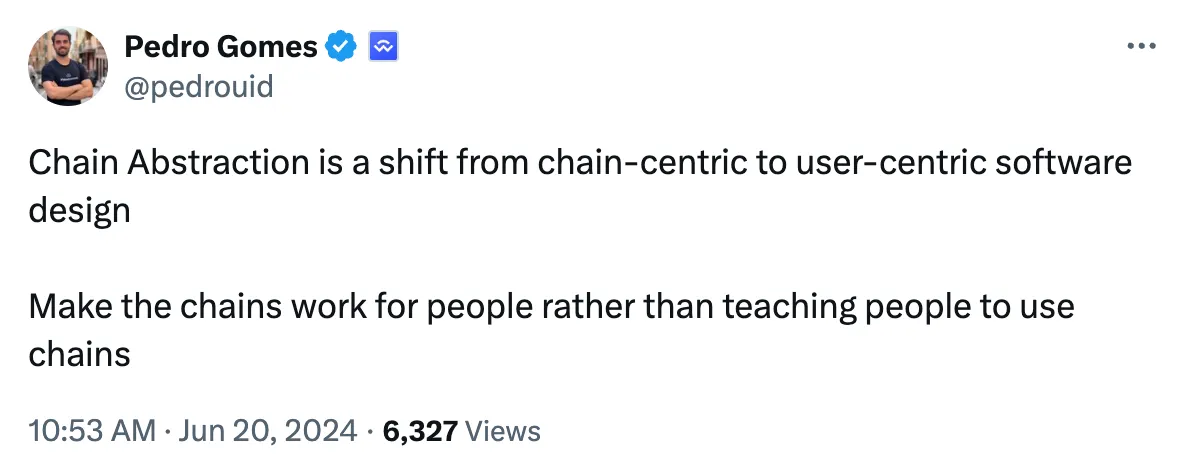
Join the official community of Deep Tide TechFlow
Telegram subscription group:
Official Twitter account:
English Twitter account:
免责声明:本文章仅代表作者个人观点,不代表本平台的立场和观点。本文章仅供信息分享,不构成对任何人的任何投资建议。用户与作者之间的任何争议,与本平台无关。如网页中刊载的文章或图片涉及侵权,请提供相关的权利证明和身份证明发送邮件到support@aicoin.com,本平台相关工作人员将会进行核查。




